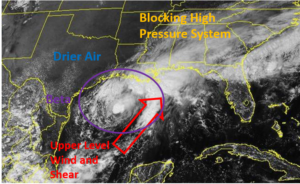A tropical cyclone is likely to form over the western Caribbean Sea during the next few days. At 8:00 a.m. EDT on Wednesday the center of Invest 99L was located at latitude 12.5°N and longitude 75.4°W which put it about 100 miles (160 km) north of Barranquilla, Colombia. Invest 99L was moving toward the west-northwest at 25 m.p.h. (40 km/h). The maximum sustained wind speed was 30 m.p.h. (50 km/h) and there were wind gusts to 40 m.p.h. (65 km/h). The minimum surface pressure was 1006 mb.
A tropical cyclone is likely to form from a tropical wave, currently designated as Invest 99L, that is over the Caribbean Sea north of Colombia. There is currently no low level center of circulation in the tropical wave. Visible satellite images were providing evidence of some rotation in the middle troposphere on Wednesday afternoon. The wave is currently in an environment that is unfavorable for the formation of a tropical cyclone. The wave is over water where the Sea Surface Temperatures are near 29°C. However, an upper level low centered near the Bahamas is producing strong southwesterly winds that are blowing across the western part of the tropical wave. Those winds are causing moderate vertical wind shear and they are inhibiting the development of the wave. Easterly winds in the lower troposphere are pushing lower section of the tropical wave quickly toward the west-northwest, which is also inhibiting development.
The tropical wave will move into an environment more favorable for the development of a tropical cyclone during the next several days. The upper low near the Bahamas is forecast to move toward the northwest and to weaken. When the upper low weakens, the vertical wind shear will decrease around the tropical wave. In addition, the wave is forecast to move more slowly when it reaches the western Caribbean Sea. The National Hurricane Center (NHC) is indicating that there is a 50% probability that a tropical depression will form from the tropical wave in the next 48 hours. NHC is indicating there is a 80% probability that a tropical wave will form during the next five days.
The tropical wave will move around the southwestern part of a subtropical high pressure system over the Atlantic Ocean. The high will steer the tropical wave toward the west-northwest during the next several days. On its anticipated track the tropical wave will approach Nicaragua and Honduras on Thursday. The system could be near the northeastern part of the Yucatan Peninsula on Friday evening. It could move over the Gulf of Mexico during the weekend. The conditions over the Gulf of Mexico could be favorable for intensification during the weekend. The Sea Surface Temperatures in the Gulf of Mexico are near 30°C. An upper level ridge is forecast to be over the Gulf. The upper level winds will be weak in the ridge and there will be little vertical wind shear. If Invest 99L is in the Gulf of Mexico during the weekend, it could strengthen to a hurricane. If it develops into a hurricane with a well formed inner core, then a period of rapid intensification could occur.
Reconnaissance planes are tentatively scheduled to begin to investigate the tropical wave on Thursday afternoon, if necessary. Invest 99L has the potential to pose a serious threat to the northwestern Gulf of Mexico. Interests in Texas, Louisiana, Mississippi, Alabama and Florida should monitor progress of the system.

